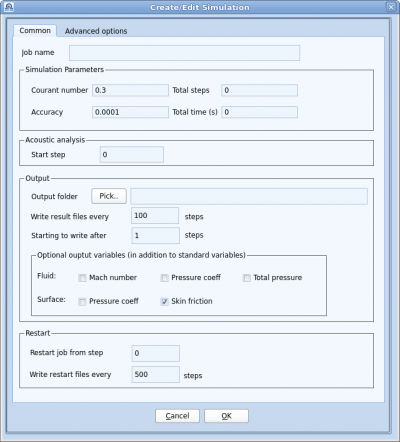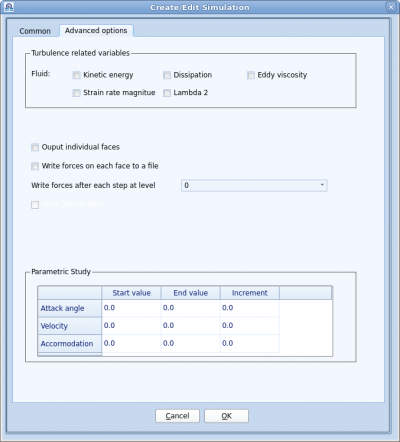Creating Job
To define a simulation, namely a job, click on the "Create" button to open the following dialog.
Contents
Job name
Job name is automatically filled in or updated when a project is saved or renamed. However user can enter any text to name the job. All simulation result files will start with this "Job name". Due to differences in different operating systems, it is strongly advised that the job name does not contain space and special characters.
Simulation parameters
- Courant number
- Similar to most transient analysis software, Courant number is directly proportional to the timestep size. A small Courant number will improve stability, but would require more increments to reach a desired solution. Users shall experiment with Courant number for new simulations to find the optimal value for both stability and efficiency.
- Total steps
- This input controls the total number of increments the simulation will run, regardless of timestep size. Simulation completes after the total number of steps is reached. Set this input to 0 to disable it.
- Total time
- This input controls the total physical time for the simulation, regardless of total steps. Enter 0 to disable. When both "Total steps" and "Total time" are given, simulation completes when one of them is reached.
- Acoustic analysis
- Enter the starting step for acoustic analysis, 0 to disable acoustic analysis. Typically acoustic analysis starts after the simulation has reached a relatively stable state, i.e. all initial transient effects have been dissipated.
Request output
Output folder
Output folder by default has the same name as the project. Users are free to assign a name or pick an existing folder. It is desirable to keep the output folder inside the project folder.
Output frequency
- Output frequency
- This means write output every N steps. Here one step means level 0. This is the frequency the flow field is written to disk. Some other quantities, such as force and measurement/probe outputs are dumped at different frequencies.
- Output start step
- Sometimes users are not interested in the initial results. This input is designed as a convenient way to save disk spaces.
Output variables
Users can select some of the variables to output. These selectable variables are in two categories: Fluid and Surface. Turbulence related variables are in the "Advanced options" tab. They will not be written if the analysis is DNS. It may be noted that certain variables, such as density, temperature and velocity, are always written for postprocessing.
Restart simulation
Restart is a nice feature when a simulation was terminated early due to various reasons. One common situation is after performing postprocessing user finds it's necessary to run the analysis for more steps. Some of the analysis parameters, such as the Courant number can be modified for restart.
The number of MPI processes must be the same in the restart run.
- Restart from step
- When it's non zero the simulation is in restart mode. The relevant information for the specified restart step must have been stored in previous analysis. In the output folder there should be a folder named restore.N, where N is the requested restart step. If that folder does not exist an error will be reported and the simulation will terminate.
- Restart file frequency
- This number specifies how frequent a restart point is written. By default the last two restart points are kept.
Third party format
Several other popular formats are supported in addition to the generic output format. Users can request formats such as TecPlot and Plot3D for fluid and surface results. Force history is a .csv text file that can be imported many postprocessing software.

